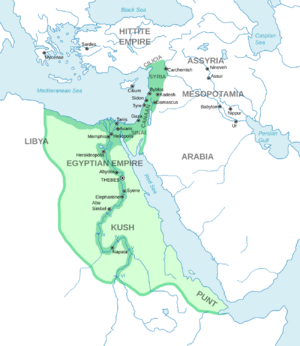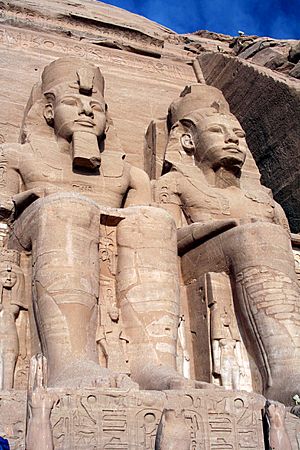New Kingdom facts for kids
The New Kingdom was a super important time in ancient Egypt. It lasted from about 1570 BC to 1070 BC. During this period, Egypt was at its strongest and wealthiest. It included three main ruling families, called Dynasties: the Eighteenth, Nineteenth, and Twentieth.
Egypt grew a lot during this time. Its armies went far south into Nubia. They also controlled large areas in the Near East. Egyptian soldiers even fought against the Hittites for land in what is now Syria. Egypt became bigger than ever before!
Contents
Famous Pharaohs and Queens
The Eighteenth Dynasty had some of Egypt's most famous Pharaohs. These included Akhenaten and Tutankhamun.
Queen Hatshepsut
Queen Hatshepsut was a powerful female pharaoh. She focused on making Egypt rich through trade. She sent a big trading trip to a faraway place called the land of Punt. This helped Egypt get many new goods.
Thutmose III, the Warrior King
Thutmose III was a great military leader. People sometimes call him the "Napoleon of Egypt." He made Egypt's army much stronger. Under his rule, Egypt built the largest empire it had ever seen.
Akhenaten and His New God
Akhenaten, who was first called Amenhotep IV, changed his name. He did this to honor a new god, the Aten. He started a religion that believed in only one god, Aten. This was one of the first times in history that a whole country worshipped just one god. He moved the capital city to a new place.
Ramesses II, the Great Builder
Ramesses II was a pharaoh from the Nineteenth Dynasty. He is often called "the Great." He tried to get back lands in the Levant that Egypt had lost. He led Egyptian armies against the Hittite king Muwatalli II. This happened in the Battle of Kadesh. Ramesses II was ambushed, but he still managed to win the battle. He also built many amazing temples and monuments.
Images for kids
-
Hatshepsut as a Sphinx. She was a powerful queen who ruled as pharaoh.
-
Thutmose III, a great military leader who expanded Egypt's lands.
-
Akhenaten, the pharaoh who introduced the worship of one god, the Aten.
-
Nefertiti, the wife of Akhenaten and a very important queen.
-
Abu Simbel Temple of Ramesses II.
-
Queen Ahmose-Nefertari.
See also
 In Spanish: Imperio Nuevo de Egipto para niños
In Spanish: Imperio Nuevo de Egipto para niños












